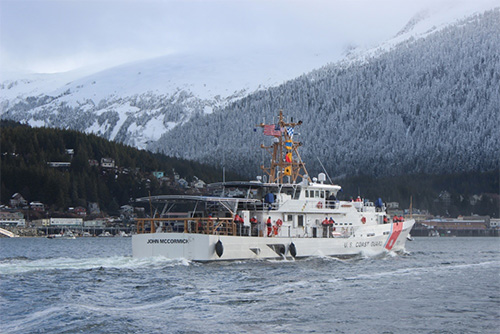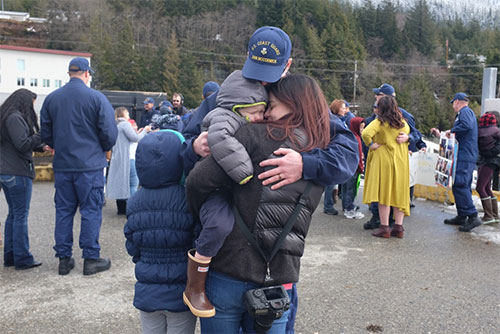
Fast Response Cutter John McCormick arrives in KetchikanBy MARY KAUFFMAN March 17, 2017
The cutter will be the first FRC stationed in Ketchikan, Alaska. It was the third consecutive FRC delivered with zero production discrepancies, indicating improved stability and efficiency in the production process.
The Coast Guard Cutter John McCormick (WPC-1121) and crew make way to their home port at Coast Guard Base Ketchikan, March 17, 2017. The Fast Response Cutter McCormick and its crew completed a 6,200-mile trip fmor Key West, Florida.
"We are pleased to welcome the crew of the new Fast Response Cutter John McCormick to the Ketchikan community," said Capt. Shannan Greene, commander of Coast Guard Sector Juneau. "The new cutter and its crew will provide greater service and enhanced capabilities for the southeast Alaska area and its maritime communities." The 154-foot FRC is designed to patrol coastal regions and features advanced command, control, communications, computers, intelligence, surveillance and reconnaissance equipment; the ability to launch and recover standardized cutter boats from astern or via side davits; and improved seakeeping and habitability. The FRCs, which are replacing the 1980s-era 110-foot Island-class patrol boats, feature an endurance of five days and reach a maximum speed of over 28 knots. The John McCormick is the first fast response cutter on the West Coast and will provide increased capabilities compared to the smaller 110-foot patrol boats it is replacing.
USCG BM1 Andrew Statham, a crew member aboard the Coast Guard Cutter John McCormick, greets his family after the Fast Response Cutter and crew arrived at its new homeport during a homecoming ceremony at Coast Guard Base Ketchikan, March 17th,
The 154-foot sentinel-class cutter was named after Boatswain John McCormick who received a Gold Lifesaving Medal for his actions on March 26, 1938. McCormick rescued Surfman Richard Bracken who fell overboard from the motor lifeboat Triumph at the mouth of the Columbia River. The vessel's manufacturer, Bollinger Shipyards, of Lockport, Louisiana, delivered the ship to the Coast Guard on December 13, 2016, for her acceptance trials. The John F. McCormick will be commissioned in April 12, 2017 in Ketchikan. The Cutter John McCormick is the Coast Guard's 21st Sentinel-class cutter, and the first to be stationed in Alaska. The Sentinel-class cutters are lightly armed patrol vessels with a crew of approximately two dozen sailors, capable of traveling almost 3,000 nautical miles, on five day missions. The cutter is a multi-mission vessel intended to perform law enforcement, search and rescue, fisheries and environmental protection, and homeland security tasks. On February 07, 2017, the Coast Guard accepted delivery of the 22nd fast response cutter (FRC), Bailey Barco, in Key West, Florida. The cutter Bailey Barco will be the second FRC stationed in Ketchikan. The 22nd fast response cutter is slated for commissioning in June 2017. The cutter Bailey Barco is named after the Dam Neck Mills, Virginia, lifesaving station keeper and boat coxswain Bailey Barco, who led a daring rescue of crewmembers of a schooner that had run aground off Virginia Beach, Virginia, Dec. 21, 1900. Barco was awarded the Gold Lifesaving Medal Oct. 7, 1901, for his actions. After the passing of several well-known Coast Guard heros, in 2009 Charles "Skip" W. Bowen, who was then the Master Chief Petty Officer of the Coast Guard, is credited with leading the initiative of naming the new vessels after enlisted rank individuals who served heroically in the Coast Guard, or one of its precursor services. The FRCs are replacing the 1980s-era 110-foot Island-class patrol boats and feature advanced command, control, communications, computers, intelligence, surveillance and reconnaissance equipment; the ability to launch and recover standardized cutter boats from astern or via side davits; and improved seakeeping and habitability. The 154-foot FRC is designed to patrol coastal regions and has an endurance of five days. Acquiring the 58 cutters is expected to cost the federal government $3.8 billion - an average of about $65 million per cutter.
Source of News:
Representations of fact and opinions in comments posted are solely those of the individual posters and do not represent the opinions of Sitnews.
|
||

